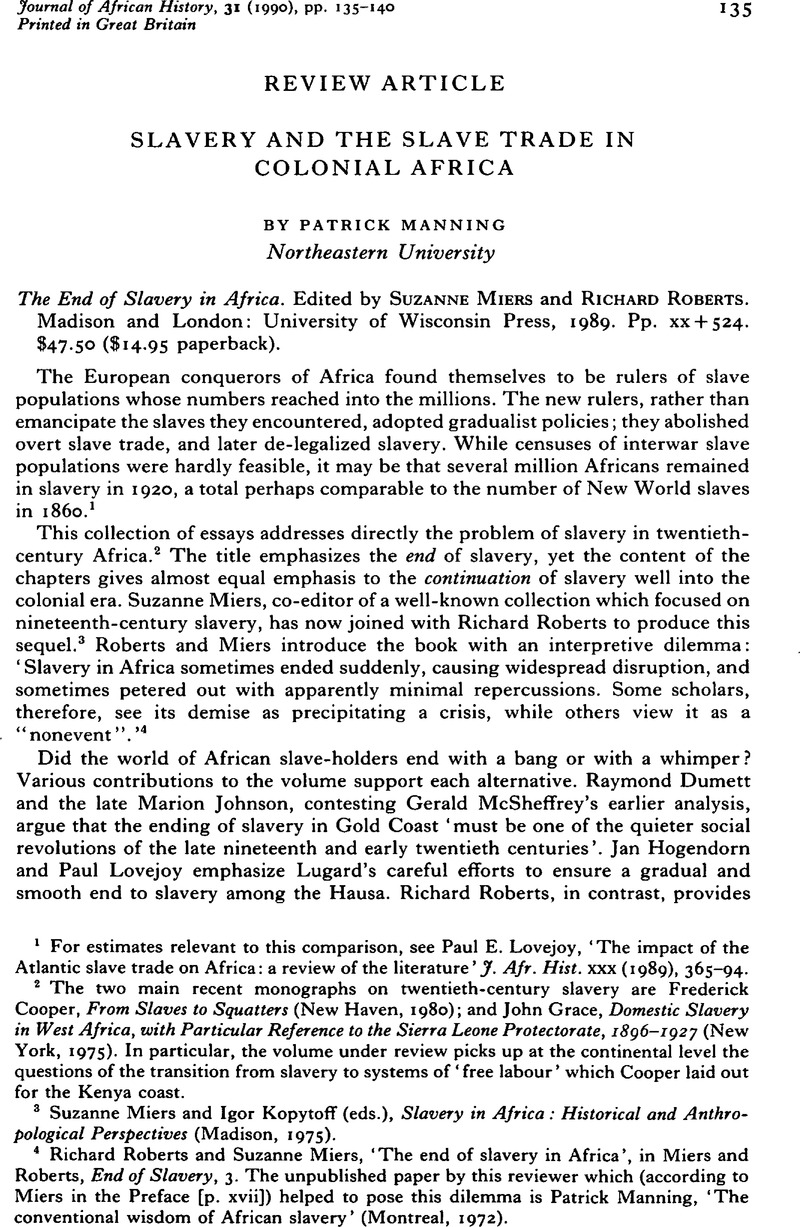Published online by Cambridge University Press: 22 January 2009

2 The two main recent monographs on twentieth-century slavery are Cooper, Frederick, From Slaves to Squatters (New Haven, 1980)Google Scholar; and Grace, John, Domestic Slavery in West Africa, with Particular Reference to the Sierra Leone Protectorate, 1896–1927 (New York, 1975)Google Scholar. In particular, the volume under review picks up at the continental level the questions of the transition from slavery to systems of ‘free labour’ which Cooper laid out for the Kenya coast.
3 Miers, Suzanne and Kopytoff, Igor (eds.), Slavery in Africa: Historical and Anthropological Perspectives (Madison, 1975).Google Scholar
4 Richard Roberts and Suzanne Miers, ‘The end of slavery in Africa’, in Miers, and Roberts, , End of Slavery, 3.Google Scholar The unpublished paper by this reviewer which (according to Miers in the Preface [p. xvii]) helped to pose this dilemma is Manning, Patrick, ‘The conventional wisdom of African slavery’ (Montreal, 1972).Google Scholar
5 Roberts, and Miers, , ‘End of Slavery’,51.Google Scholar
6 Igor Kopytoff, ‘The cultural context of African abolition’, Miers, and Roberts, , End of Slavery, 488, 494, 497, 501.Google Scholar
7 Meillassoux, C., Anthropologic de l'Esclavage: le ventre de fer et d'argent (Paris, 1986).Google Scholar
8 Higman, B. W., Slave Population and Economy in Jamaica, 1807–1834 (Cambridge, 1976)Google Scholar; Craton, Michael, Searching for the Invisible Man: Slaves and Plantation Life in Jamaica (Cambridge, Mass., 1978), 70, 135–87Google Scholar; Eltis, David, Economic Growth and the Ending of the Transatlantic Slave Trade (New York, 1987);Google ScholarJohn, A. Meredith, The Plantation Slaves of Trinidad, 1783–1816: A Mathematical and Demographic Enquiry (Cambridge, 1988).Google Scholar
9 For a contrast of eighteenth-century and nineteenth-century North American slave family and culture, see Kulikoff, Allan, Tobacco and Slaves (Chapel Hill, 1986), 352–420Google Scholar; and Genovese, Eugene D., Roll, Jordan, Roll (New York, 1976), 444–582.Google Scholar
10 Meillassoux, , Anthropologic de l'esclavage; Patterson, Orlando, Slavery and Social Death (Cambridge, Mass., 1982), 2–3.Google Scholar Patterson, however, places greater emphasis on the role of violence in maintaining masters' dominance over slaves than he does on the need for imports to sustain slave populations.
11 Toplin, Robert Brent (ed.), Slavery and Race Relations in Latin America (Westport, Conn., 1974)Google Scholar, especially chapters by William F. Slater on Chile and John Lombardi on Venezuela. For general surveys of abolition and emancipation in the New World, see Klein, Herbert S., African Slavery in Latin America and the Caribbean (New York, 1986), 243–71Google Scholar; and Blackburn, Robin, The Overthrow of Colonial Slavery, 1776–1848 (London, 1988).Google Scholar Blackburn's study, while providing excellent detail on New World slavery, makes no reference—astonishingly—to the African continent, much less to slavery in Africa. Presumably, this follows his definition of the nature of ‘colonial slavery’.
12 Such terms as ‘destruction’ and ‘overthrow’ have been offered for the end of slavery in the Americas, in part to avoid the ambiguities of ‘abolition’. See Conrad, Robert, The Destruction of Brazilian Slavery (Berkeley and Los Angeles, 1972)Google Scholar and Blackburn, Overthrow of Colonial Slavery. For an unusually precise terminology for North America, see Berlin, Ira et al. (eds.), Freedom: A Documentary History of Emancipation, 1861–1867. Series I, Vol. I. The Destruction of Slavery (Cambridge, 1985).Google Scholar
13 Miller, Joseph C., Way of Death: Merchant Capitalism and the Angolan Slave Trade, 1730–1830 (Madison, 1988).Google Scholar